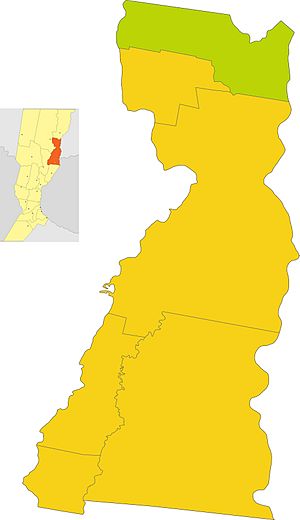Romang, Santa Fe facts for kids
Quick facts for kids
Romang
|
||
|---|---|---|
|
City and municipality
|
||
|
||

Location of Romang Municipality in San Javier Department
|
||
| Country | Argentina | |
| Province | Santa Fe | |
| Department | San Javier | |
| Population
(2012 estimate)
|
9,237 | |
| Website | www.romang.gov.ar | |
Romang is a town in Argentina, located in the Santa Fe Province. It's about 265 kilometers (165 miles) north of Santa Fe, the capital city of the province. You can find it along Provincial Route 1.
Contents
What Romang Does: Economy
Romang's main activities are farming, raising animals, and making things in factories.
Local Businesses and Tourism
Two important businesses are Susarelli, a rice factory that sells rice all over Argentina, and API. API is a factory that makes steel and car parts, also shipping them across the country.
People also visit Romang for fun! Many enjoy sport fishing. There's a big camping area called Camping Communal Brisol right by the river, which is popular with tourists.
Sports in Romang
Romang has two sports clubs: Club Matienzo and Club Romang. These clubs play soccer in the Reconquista Soccer League of Santa Fe.
Romang's Environment: Climate and Geography
Romang has a warm, humid climate. This means it gets hot summers but doesn't have a dry season.
Earthquakes and Floods
On average, Romang experiences a small earthquake about once every 50 years. These quakes are usually not very strong, less than 5 on the Richter Scale. It rarely has very dry periods (droughts). However, there is a medium to high chance of floods.
Plants, Soil, and Weather
Most of Romang's natural plants are still there, covering much of the land. The area has a type of forest called a subtropical dry forest.
The soil in Romang is often a type called planosol. This soil is common in flat areas and can get very wet during certain seasons.
Because of its subtropical climate, Romang doesn't have many dry spells. Summers are hot, with an average temperature of 29 °C (84 °F). Winters are mild, averaging 12 °C (54 °F). The wind from the South Atlantic brings a lot of moisture, which helps keep the area free of frost for a long time. Romang usually gets between 900 and 1100 millimeters (35-43 inches) of rain each year.
Romang's Story: History and Creation
The town of Romang was officially created on January 28, 1887.
Early Days and Settlers
In 1873, a man named Peter Wingeyer called people together in Romang. He had traveled from Switzerland to America. On his journey, he bought a passport from a doctor named Theophilus Romang, who sadly passed away during the trip. Wingeyer later moved to Argentina.
Wingeyer wanted to create a large farm on public land near the San Javier River. The government looked into his plans.
The main reason Romang was created was to start a new settlement. The land was known to be very rich and great for farming. People also wanted to cut down trees for wood and protect their farm animals. At that time, tribes from the Chaco region sometimes raided the area, stealing and causing trouble.
Romang was one of the few places in Argentina where the first homes needed to be built inside a fence for protection. Usually, new settlements were built near forts or military camps for safety.
Over time, more people arrived. The first settlers in 1873 included families from Italy, France, Switzerland, and Germany. Wingeyer had promised the government to bring 200 families within two years.
Names Through Time
Romang had different names before. During the time of the Jesuits, it was called San Geronimo. From 1845 to 1855, it was known as Malabrigo. After that, it received the name it uses today: Romang.
Growth and Connections
The official map of the town was made in July 1925 by engineer Juan C. Kuriger. As more people moved to Romang, the town grew. One important step for its progress was using the nearby streams for boats. This allowed Romang to connect with other ports and towns, especially Corner (Corrientes), helping with trade and travel.
See also
 In Spanish: Romang para niños
In Spanish: Romang para niños


